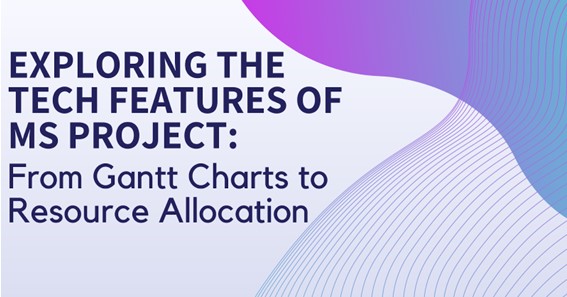Microsoft Project (MS Project) is part of the more expansive Microsoft Office suite. It is a project management solution to assist project managers in developing plans. This includes assigning resources to tasks, tracking progress, managing budgets, and analyzing workloads.
MS Project has a broad range of tech features. This makes it indispensable for anyone involved in project management. Learning to use Microsoft Project unlocks the potential for increased efficiency for individuals or organizations. This includes accuracy and success in project execution.
Over 39,000 companies globally use MS Project. This underlines its prominence in project management. It was also observed that proficient use of MS Project could lead to a 20% increase in project efficiency. This decreases project overruns and sheds light on the benefits of this tool.
Understanding the technical features of MS Project is not only a valuable skill. It’s an essential one for modern project management.
Project managers should use tools to aid their roles in this digital age. MS Project is one of the most effective and widely-used tools available. A skill in resource allocation within MS Project ensures efficient use of resources. This is where you identify overallocation and resolve it.
Let’s explore MS Project’s tech features and break each in detail to enhance your skill set. This will elevate your project management game and be your go-to resource.
What is a Microsoft Project?
Microsoft Project is project management software developed and sold by Microsoft. It assists project managers in developing plans and assigning resources to tasks. This includes tracking progress, managing budgets, and analyzing workloads.
If you’re learning to use Microsoft Project, many resources are available to help. Microsoft offers tutorials on its official website. This can be very helpful for beginners. Microsoft Project training programs can guide you through more aspects of the software. You can also use Microsoft Project Online, which is a cloud-based version.
The software provides a host of features that make project management more streamlined. The interface is intuitive and easy to navigate. Users can create Gantt charts, project timelines, and detailed reports. It also allows collaborative work that will enable teams to coordinate timelines.
What Does a Project Manager Do?
A Project Manager handles planning, organizing, and directing organizational projects. They also ensure these projects are on time, within budget, and in scope.
This role is vital in every industry and requires exceptional management skills. It includes communication, negotiation, problem-solving, and leadership.
A Project Manager’s duties often include the following:
- Setting project goals and objectives.
- Creating detailed project plans.
- Allocating resources and budgets.
- Communicating with stakeholders.
- Tracking project performance against predetermined benchmarks.
Project managers also manage risks and issues. They make adjustments as the project progresses and ensure they adhere to standards.
Click here – Decoding 2.16 As A Fraction: Simplified Explanation And Examples
To ensure efficiency and productivity, project managers use Microsoft Projects. It allows project managers to do the following:
- Assign tasks
- Manage resources
- Track progress
- Analyze workloads
Given the complexities, mastering tools like Microsoft Project is valuable.
Unveiling MS Project: Key Features and Benefits
There is a myriad of features that MS Project provides. You’ll appreciate the functionality and robustness of this Microsoft project management software.
Learning to use Microsoft Projects requires practice and patience. The investment and efficiency gained in managing complex projects are worth considering.
Notably, Microsoft Project’s user-friendly interface eases the learning curve. There are also plenty of resources available. An example is the Microsoft Project tutorial. This helps you familiarize yourself with all its features.
Microsoft Project’s tools empower project managers to track progress. Through this, they can manage resources and control project costs.
1. Gantt Charts
The first feature to consider when diving into a Microsoft Project is the Gantt Charts. This is a visual aid for tracking progress, which is crucial in project management. This visual tool makes interpreting complex project information easier.
It assists novice managers and those seeking a clear grasp of their project manager jobs. Gantt charts are indispensable in project scheduling. It is a hallmark of Microsoft Projects.
- Understanding Gantt Charts: Gantt charts visualize the project timeline. It displays tasks, durations, dependencies, and milestones. They provide a snapshot of the project’s status at a glance.
- Creating and Modifying Gantt Charts: MS Project makes creating a Gantt chart from your tasks easy. Change the chart by adjusting task durations. You can add dependencies or move tasks around.
- Reading and Interpreting Gantt Charts: The power of Gantt charts lies in their readability. Microsoft Project’s Gantt charts use bars and connectors. This depicts task relationships, progress, and completion status.
2. Project Scheduling and Planning
The purpose of any project management tool is to aid in project scheduling and planning. Microsoft Project excels in this aspect. Microsoft Project allows you to establish a solid foundation from the get-go.
- Setting Up the Project Calendar: Define the working and non-working days. This is to map the project’s timeline and customize working hours. Do this to reflect your organization’s specific schedule.
- Creating Tasks: MS Project’s task creation feature is intuitive and comprehensive. It allows you to set task names and durations. This includes start and end dates and more.
- Estimating Task Duration: Microsoft Project supports fixed units, work, and duration. Depending on the nature of the task, you can choose the type to estimate how long it will take.
3. Resource Allocation
The successful allocation of resources is a crucial element of project management. Fortunately, Microsoft Project’s resource management tools are robust and user-friendly.
Proper resource allocation helps prevent overutilization or underutilization. This leads to cost savings and efficiency. This is one reason why project managers resort to Microsoft Project management tools.
- Defining and Adding Resources to an MS Project: Adding resources to your project is simple. You can add people, materials, or equipment as resources. This includes assigning specific availability and costs to each.
- Assigning Resources to Tasks: Once you’ve added resources, you can assign them to tasks. This simple act transforms your task list into a dynamic, actionable project schedule.
- Managing Overallocated Resources: MS Project flags overallocated resources. This assists you in identifying potential bottlenecks. It even provides suggestions to resolve overallocation. Examples include adjusting assignments or extending task durations.
4. Cost Management
Managing project costs is crucial to project success. Luckily, MS Project has robust tools to help.
- Creating and Managing Budgets with MS Project: MS Project enables the creation and management of project budgets. Define costs at the resource level and let MS Project calculate the cost. Base this on task assignments and resource rates.
- Setting Up Costs for Resources: You can assign standard and overtime rates. This is for work resources and a per-use cost for material resources. This flexibility is beneficial when different resources have varying costs.
- Tracking Project Costs and Analyzing Variances: MS Project can track actual costs. This is against your baseline as the project progresses. Any variances will become evident, allowing you to react.
The software is only as good as the project manager who wields it. Hence, enhancing your skills with MS Project can increase your worth as a project manager. It could boost your salary and broaden the range of project manager jobs.
5. Risk Management in Microsoft Project
Effective risk management is a crucial aspect of successful project management. Microsoft Project incorporates features that help in identifying and assessing. This includes monitoring potential project risks.
The risk management feature of Microsoft Project provides several significant benefits:
- Proactive Management: Identifying and planning for risks beforehand allows for proactive management. You’re not reacting to problems as they arise. You’re anticipating and preparing for them in advance.
- Informed Decision-Making: MS Project supports informed decision-making by providing detailed information about each risk. You can make decisions based on a comprehensive understanding of the potential implications.
- Improved Project Outcomes: Effective risk management can lead to better project outcomes. You can keep your project on track by minimizing the impact of risks. This allows you to improve the likelihood of achieving your project goals.
- Enhanced Communication: The software facilitates communication about risks. You can share risk information with your team and stakeholders. This ensures everyone is aware of potential issues and the plans for addressing them.
Unleash Your Project’s Potential
Microsoft Project can streamline the project management process. The effectiveness of Microsoft Project lies in fostering systematic project management. It offers tech features that allow you to plan, track, and control every aspect of your project.
Learning to use Microsoft Projects is a worthwhile investment for any project manager. This includes individuals involved in project planning and management.
Microsoft Project is a software program with countless features to enhance project management process. Whether you’re a novice or a seasoned project manager, there’s more to learn about MS Projects.
Microsoft Project isn’t only a tool; it’s an enabler. It enhances your skills as a project manager. The tool helps you deliver projects on time and within budget, the project’s primary goal. So, continue learning to use Microsoft Project. The more proficient you become, the better you can manage your projects.
Every feature and every trick you learn can be the key to overcoming a future project challenge. So, whether it’s through Microsoft Project training or hands-on experience, continue your journey.






